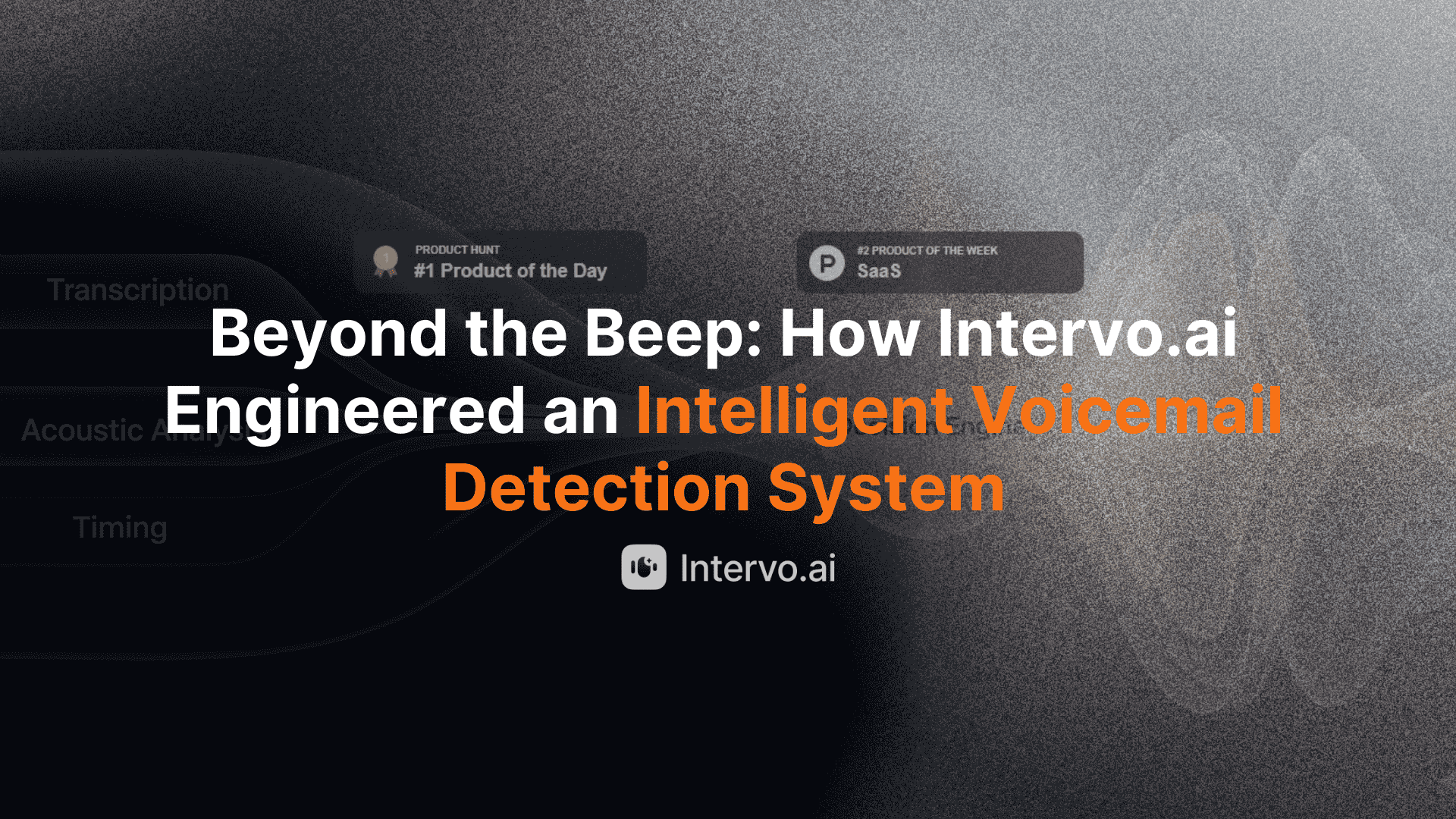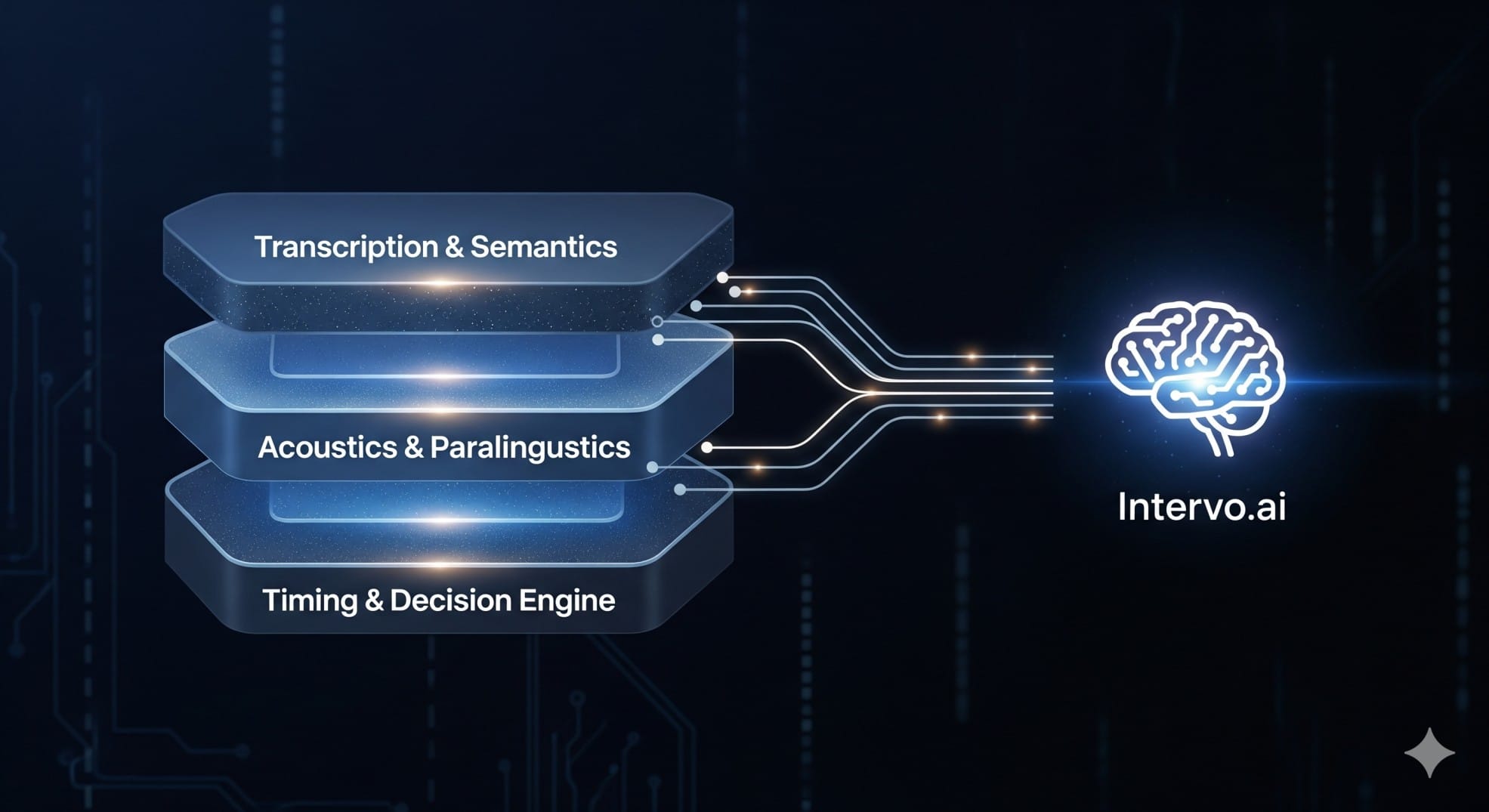Beyond the Beep: How Intervo.ai Engineered an Intelligent Voicemail Detection System

At Intervo.ai, our mission is to build autonomous AI agents that can engage in meaningful, human-like conversations. But what happens when no human is on the other end of the line?
For any outbound calling system, this is a critical, multi-million-dollar question. An AI agent that can’t distinguish a live person from a recording isn't just inefficient—it's a bad experience. It wastes time, burns through calling credits, and makes your brand look unsophisticated when it starts pitching a voicemail greeting.
This is the classic challenge of Voicemail Detection (VMD). And as we discovered, solving it reliably requires looking far beyond the simple "beep."
The High Cost of "Hello, you've reached..."

On the surface, the problem seems simple: just listen for a beep, right?
But in the real world, this problem is incredibly complex. Traditional VMD systems that rely on simple heuristics are notoriously unreliable.
- The Unreliable Beep: Many services no longer use a standard 1000Hz beep. Some have short beeps, long beeps, custom tones, or simply say, "...leave your message now." Relying on the beep alone is a guaranteed recipe for failure.
- The "Human" Machine: Voicemail greetings are designed to sound personal. "Hi, you've reached Sarah, I'm not available..." can easily trick a simple AI into thinking it's talking to a real person. The agent might launch into its script, only to be cut off by the tone.
- The Silence Trap: What about the pause after the greeting? A human knows to wait for the beep. A naive AI might mistake this silence for the end of the conversation and hang up, or worse, start talking over the end of the greeting.
- The IVR Labyrinth: Not all machines are voicemails. "Thank you for calling... press 1 for sales" is an IVR, not a voicemail box. An intelligent agent needs to differentiate, as the correct action isn't to hang up, but to navigate the menu.
Any one of these failure points can derail an AI agent, breaking the automation and costing you a potential lead.
The Intervo.ai Multi-Layered Approach

We knew a simple, single-signal system wouldn't work. To achieve the 98%+ accuracy our clients require, we had to build a multi-layered, real-time decision engine that acts like a human ear, processing multiple signals at once.
Our VMD system analyzes the first few crucial seconds of every call across three distinct layers simultaneously.
Layer 1: Real-Time Transcription & Semantic Analysis
As soon as the line connects, our system begins transcribing the audio in real-time. But it doesn't just look for simple keywords like "voicemail" or "message."
Our model is trained to understand the semantic intent of the greeting.
"Hello?"(spoken with an upward inflection) has a clear "live human" intent."Hi, this is John..."has a "human greeting" intent."You have reached the office of..."has a "voicemail/greeting" intent.
By analyzing the meaning and structure of the sentence, we can quickly identify the patterns of a pre-recorded message, even if it uses unconventional wording.
Layer 2: Acoustic & Paralinguistic Cues
This layer ignores what is being said and focuses on how it's being said. A human answering a phone sounds fundamentally different from a recording.
- Pitch & Intonation: A live "Hello?" has a characteristic upward inflection and energy. A recorded greeting is often flatter, more monotone, and follows a predictable acoustic pattern.
- Cadence & Pace: Recorded messages are spoken at a consistent, even pace. A live human's speech is more varied, with natural pauses, "ums," and "ahs."
- Audio Quality: Greetings often have a slightly "canned" or compressed audio signature compared to the raw audio of a live connection.
Our acoustic models are trained on hundreds of thousands of call snippets to instantly spot the subtle, non-verbal signatures of a recording.
Layer 3: The Decision Engine & Timing Analysis
No single layer makes the final call. The data from our transcription and acoustic models is fed, millisecond-by-millisecond, into a central machine-learning model.
This engine weighs the evidence:
- Does the transcription sound like a greeting?
- Does the audio feel like a recording?
- Is there a characteristic pause after the greeting?
- And finally, yes, was there a "beep"? (We still use it as a final, strong confirmation signal if it's present).
This engine outputs a confidence score—e.g., "99.2% Voicemail" or "97.5% Human"—all within the first 800 milliseconds of the call.

The Result: A Smarter, More Efficient AI Agent

This high-accuracy, low-latency VMD is what separates a true AI agent from a basic robocaller.
When Intervo.ai detects a human with high confidence, the agent begins its conversation seamlessly, with no awkward delay.
When it detects a voicemail, it executes the smart action you've defined. Instead of just hanging up, it can:
- Drop a Dynamic Voicemail: Instantly leave a pre-recorded, personalized voicemail (e.g., "Hi [Lead Name], this is [Agent Name]..."), saving your agent's time.
- Schedule a Retry: Silently hang up before the beep and automatically schedule a call-back for a different time of day.
- Trigger an SMS: Immediately send a text: "Sorry I missed you, [Lead Name]. Is there a better time to chat?"
Ultimately, robust voicemail detection isn't just a minor feature; it's the bedrock of an efficient autonomous calling system. It's what allows our AI agents to navigate the real world intelligently, ensuring every call has a purpose and no opportunity is wasted.

Want to see our intelligent agents in action?Book a demo with Intervo.ai today!
Frequently Asked Questions (FAQ)
1. What is the typical accuracy of Intervo.ai's Voicemail Detection?
While no VMD system can be 100% accurate due to the sheer variety of greetings and connection types, our multi-layered decision engine consistently achieves accuracy rates above 98%. This is significantly higher than traditional "beep detection" or simple silence-based timers, drastically reducing the chance your AI agent will mistakenly talk to a machine.
2. How fast is the detection, and does it impact call costs?
The detection is extremely fast, with a confident decision (human vs. machine) typically made in under 800 milliseconds. This speed is a key advantage. By identifying a voicemail before the "beep" (which is often when billing begins for many carriers), our system can hang up instantly. This speed doesn't just improve the agent's efficiency—it actively saves you money by minimizing call duration on non-productive dials.
3. How is this different from the "Answering Machine Detection" (AMD) my current dialer has?
Traditional AMD is often a simple, single-signal system. It listens for a specific audio tone (the "beep") or waits for a fixed period of silence. As the blog post explained, this is highly unreliable. Intervo.ai's VMD is a multi-modal AI model that simultaneously analyzes what is said (transcription), how it's said (acoustic patterns), and the timing of the audio. This allows it to make a far more intelligent and reliable decision.
4. Can I customize what the AI agent does when it detects a voicemail?
Absolutely. This is a core part of our platform. You have full control over the workflow. When a voicemail is detected, you can configure the agent to:
- Hang up silently to simply mark the lead for a retry.
- Drop a pre-recorded voicemail that can be dynamically personalized.
- Trigger an automated SMS or email to the lead ("Sorry I missed you...").
- Update the lead's status in your CRM automatically.
5. Does your system also handle other non-human responses, like IVRs or "number disconnected" messages?
Yes. Our intelligent audio analysis isn't just trained for voicemails. It can also identify the characteristic prompts and audio of an IVR (Interactive Voice Response). In many cases, the agent can even be configured to navigate the IVR (e.g., "Press 1 for sales"). Furthermore, it recognizes common carrier-level messages, such as "This number is not in service," allowing it to instantly disposition the call correctly without wasting any agent time.

